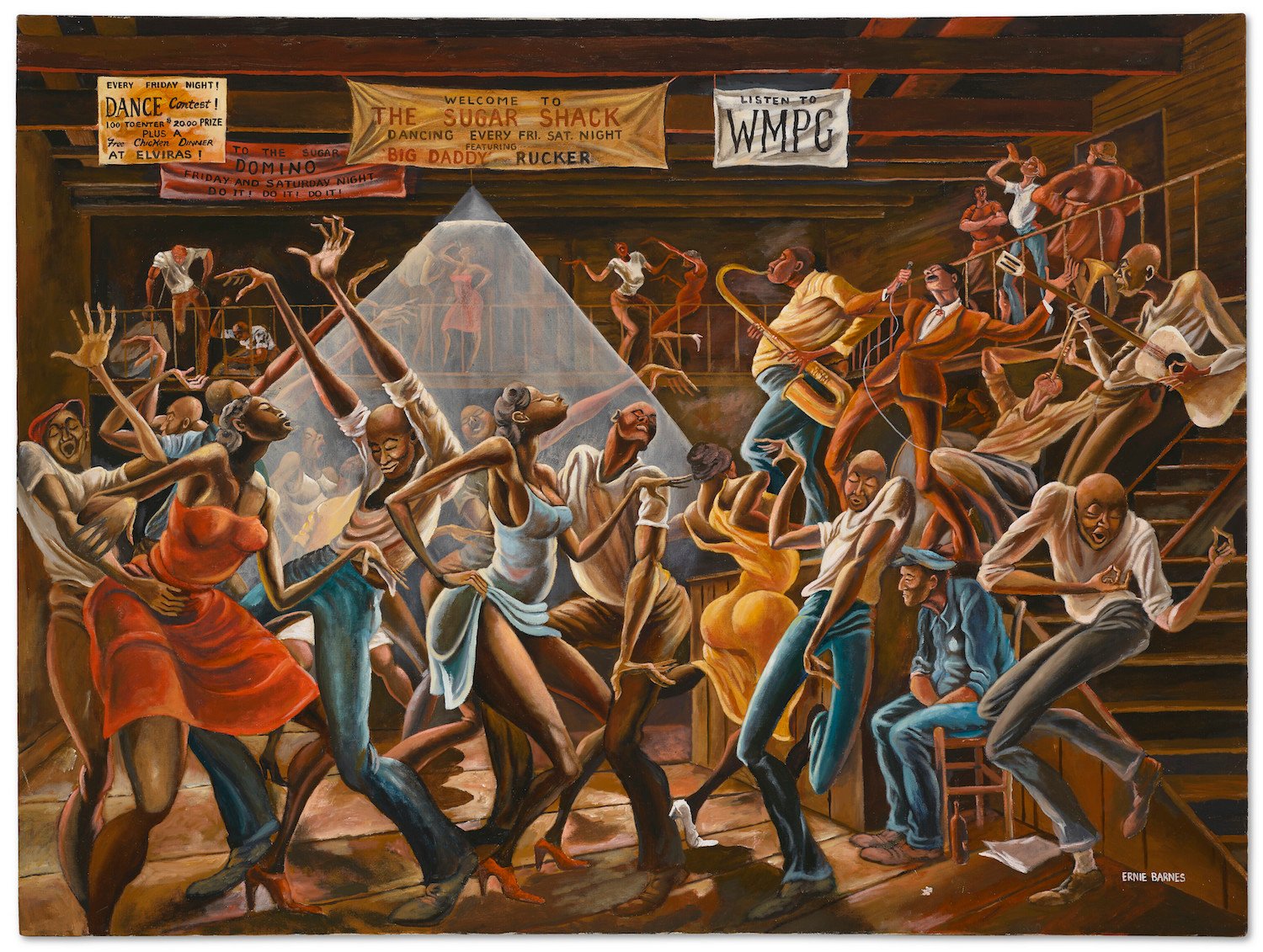
“The secret’s out,” said Bill Perkins, the Houston-based entrepreneur and amateur poker player, who fought off intense competition from another bidder at Christie’s evening sale last night to win a masterpiece by the late African American painter Ernie Barnes, The Sugar Shack (1976), for $15.3 million. The work had been estimated at just $150,000 to $200,000, so the final price was roughly 75 times that.
“You know those scenes in Westerns, or Pirates of the Caribbean, where everybody is fighting and Johnny Depp just walks in and out with the treasure?” Perkins said. “That’s been me at every other auction.”
The collector has been buying online for the past few years, and owns numerous other works by Barnes, as well as examples by Charles White and John Biggers. He has been happily astounded at their relative affordability. “I’m walking away with the treasure while everybody is fighting over a Warhol or a Monet,” he added.
Bill Perkins and his fiancé Lara Sebastian at Christie’s, with Ernie Barnes’s The Sugar Shack(1976). Perkins won the work for $15.3 million after a lengthy bidding war. Image courtesy Bill Perkins.
However, Perkins admits that last night, after having flown to New York from Houston solely to bid in person, he knew something was up when auctioneer Adrien Meyer announced that there were 22 telephone lines set up to compete. The Sugar Shack (1976) shows a group of Black dancers exuberantly enjoying a night at the Durham Armory, a famous dance hall in segregated North Carolina, in 1952. It was not only the cover image for Marvin Gaye’s 1976 album I Want You, it was also featured in the television show Good Times, as the credits rolled at the end of each episode.
“This image has been in my consciousness since I was a kid. I have an emotional connection to it,” Perkins says. He’s friends with artist Rick Lowe (currently featured in the Whitney Biennial) who has been advising and informing him about Barnes and other artists. “I never thought I could own this piece,” Perkins says. “As I got in a position where I could buy it, I thought, wouldn’t it be amazing if I could own this iconic piece of American history, a very important, significant work.”
Perkins said asking how the painting came on his radar is kind of like asking how someone knows about the Mona Lisa. “If I did a survey, and I put a picture of the Mona Lisa and a picture of The Sugar Shack side by side, in my group of African Americans, they’re going to remember The Sugar Shack more than anything else.”
He added that he can’t think of a similar scenario in which a work of art was featured on an album cover and then on a groundbreaking TV show—which he notes was one of the first ever to feature a Black family and introduce Americans to Ernie Barnes and his art.
When Meyer opened the bidding somewhere below the reserve price, Perkins, who was seated at the back of the auction room, yelled out $500,000—already more than double the high estimate. As the phone competition quickly dropped away, the contest came down to just two bidders, Perkins and another gentleman on a cellphone a few rows ahead of him.
The price kept climbing—to $1 million, then $2 million, and up and up. Perkins said it was almost “serendipitous” that the competing bidder was visible to him. Rumor has it that he is an art advisor for Gurr Johns and was bidding on behalf of the Lucas Museum of Narrative Art in California, which was founded by George Lucas and his wife Mellody Hobson. A representative for the museum did not respond to request for comment.
As the price approached $7 million, the man turned around to Perkins and said, “I’m not gonna stop.” Perkins fired back, “Well then I’m gonna make you pay”—and the audience erupted into laughter.
It was still game on. The work finally hammered to Perkins for $13 million, with a hearty round of applause.
Perkins spoke to Artnet News on Friday from the airport in New York on his way back to Houston. Part of the reason he made the trip was that he was nervous something could go wrong, such as a dropped phone line or other unforeseen glitch.
He has mixed feelings about the historic undervaluation of work by African American artists. “As a novice, I’m buying what I like. There is American art, and there’s Black art and Black artists, and its like this sub-category. I don’t know all the reasons, I think collectors before thought, ‘Well I’m going to support this,’ and there was this kind of charitable endeavor to it. When I came along, I’m thinking, ‘These are basically free.’ This is such an integral, foundational part of history. Black history is why America is an empire. These stories are important, but it’s as if people have been put it in this other category.”
On the other hand, he added, “it’s great—I don’t have to bid against Hong Kong, or Russian oligarchs or French billionaires. It’s this open secret. This thing right in front of your face that more than two-thirds of the art world is not paying attention to. So it’s been good and bad.”
After last night, there’s no denying the secret is out—but Perkins is thrilled nonetheless. In his view, “this is a $100 million painting and I’m buying it for $15 million.”
Of his collection, which also includes work by husband-and-wife duo Dabsmyla, Roy Lichtenstein, Angelbert Metoyer, and Augusto Torres, he says: “I get to enjoy them and transmit them to future generations at a low rent cost. I say ‘rent’ because when you buy stuff like this, you get to have it for a while, and then you die and it goes to somebody else.”